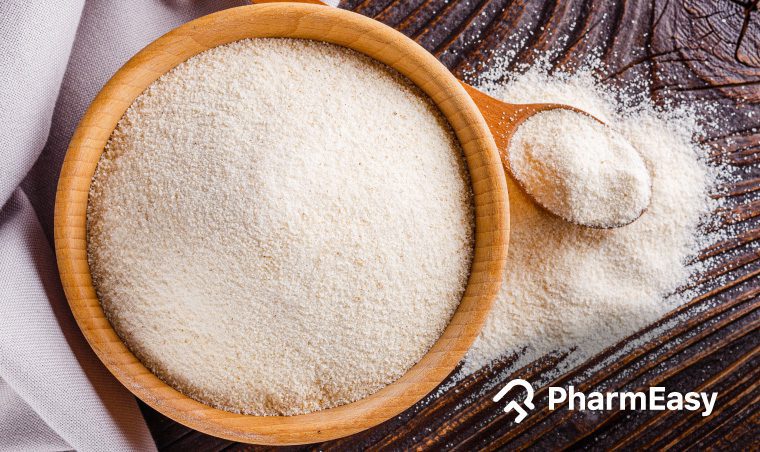Suji (Semolina): Uses, Benefits, and Side Effects
By Dr. Malavika Athavale +2 more

Get,

to manage your symptom
Get your,


4 Cr+ families
benefitted

OTP sent to 9988776655



You’ve successfully subscribed to receive
doctor-approved tips on
Whatsapp

Get ready to feel your best.

Hi There,
Download the PharmEasy App now!!


Register to Avail the Offer
Send OTPBy continuing, you agree with our Privacy Policy and Terms and Conditions

Hi There,
Sign up on PharmEasy now!!
Trusted by 4 crore+ families

OTP sent to 9988776655



You have unlocked 25% off on medicines




Code: NU25
By Dr. Malavika Athavale +2 more
Table of Contents
Suji is also known as semolina which is called rava in Indian households, is a by-product of durum wheat. Suji, also known as coarse middlings, is made from durum wheat, scientifically called Triticum durum, a cereal crop widely cultivated in the Mediterranean region. Suji is a versatile ingredient that can be used for breakfast, lunch, dinner, or snacks. It is particularly convenient on busy days as it can be cooked quickly into a variety of dishes. In Indian cuisine, suji is extensively used to prepare popular recipes such as rava dosa, upma, dhokla, and many others. Let’s explore some of the benefits of semolina (suji)1.

Suji contains various nutritional components given as follows2:
Suji may possess the following properties3:
Some of the potential uses of suji are described as follows:
Suji may have immunoregulatory properties (balancing the immune cell functions) that may help to build immunity. A constituent arabinoxylan, present in suji may also help in stimulating the immune system to fight against diseases. Further studies are required to assess the true effect of suji on the immune system in the human body3.
Suji may have anti-diabetic properties due to the presence of a plant constituent, arabinoxylans. Consumption of suji may lower the blood sugar level rise after that meal. However, you must check your blood sugar level regularly and consult your doctor in case of high blood sugar levels instead of self-medicating3.
Suji may be used in the case of cardiovascular diseases to improve heart health. Tocopherol and phenols which are the plant constituents present in suji may reduce the risk of heart diseases. However, further studies are required to study the effect of suji on the human heart. Seek medical help immediately if you experience any symptoms related to heart disease3.
Suji is an important source of dietary fibre and consumption of dietary fibre may be associated with a reduced risk of colon cancer. However, further studies on animals and humans are required to check the effect of suji on reducing the risk of colon cancer. Cancer is a serious disease; therefore, so it is essential to seek proper medical treatment rather than attempting to self-medicate3.
Suji is a good source of dietary fibre and it plays an important role in gastrointestinal function (function related to the stomach and intestine). Suji may help accelerate digestion and increase the faecal bulk, potentially supporting overall digestive health and promoting regular bowel movements. Further studies are required to check the effect of suji on the digestive health of humans. However, you must consult your doctor if you feel discomfort in your stomach3,5.
Suji may be used to control the cholesterol levels in the body, possibly due to a compound called arabinoxylans, which has antioxidant properties. However, further studies are required to check the activity of suji for controlling cholesterol. It is important to have your cholesterol levels checked regularly and to consult your doctor if you have high cholesterol3,6.
The dietary component that encourages the development of healthy intestinal bacteria is known as prebiotics. Suji may have a prebiotic effect that supports gut health. This effect is thought to be linked to a component called arabinoxylans, which may help reduce the risk of several chronic diseases. The prebiotic properties of suji might promote easier bowel movements, support healthy intestinal function, and enhance immune response. However, further research is needed to fully evaluate the prebiotic effects of suji on the human body3.
Suji may possess antioxidant properties, primarily due to the presence of ferulic acid. It may help deactivate and eliminate harmful free radicals, which are linked to the development of various chronic diseases. This activity could enhance the function of enzymes responsible for the body’s antioxidant defence. However, further studies are needed to confirm the antioxidant effects of suji in humans3.
Though studies show the benefits of suji in various conditions, these are insufficient. There is a need for further studies to establish the true extent of the benefits of suji on human health.
Based on my experience, durum wheat, including its whole grains and whole-grain flour may possess antimicrobial properties. This is attributed to the presence of Azelaic Acid (AzA), a compound known for its antibacterial and anti-inflammatory effects. AzA is commonly used in the treatment of conditions such as acne vulgaris and rosacea, and its presence in durum wheat suggests it may play a role in the grain’s antimicrobial benefits9.
Dr. Rajeev Singh, BAMS
Suji is a versatile ingredient that can be used in a variety of cuisines. It is commonly used to prepare traditional dishes such as idli, dosa, dhokla, upma, pasta, cakes and many more food items can be made from suji.
You must consult a qualified doctor before taking suji regularly. Do not discontinue or replace an ongoing treatment of modern medicine with an ayurvedic/herbal preparation without consulting a qualified doctor.
Since suji is made of durum wheat, it may trigger a wheat allergy in some individuals. Possible side effects of a wheat allergy include5:
Did you know that durum wheat, scientifically known as Triticum durum, is the second most cultivated species of wheat species after the common wheat? Interestingly, durum wheat is particularly rich in gluten and is considered the toughest among all wheat varieties8.
Dr. Siddharth Gupta, B.A.M.S, M.D (Ayu)
Consumption of suji may be a risk for those who are allergic and intolerant5.
General precautions should be taken while having suji, as in any other general medicine. Pregnant women and lactating mothers should take special care. You must consult your doctor before having suji. Precautions should be taken before giving suji to the elderly or children. In such cases, you must have suji only if your doctor prescribes it.
Also Read: Pudina (Mint): Uses, Benefits, Side Effects & More!
There is not enough evidence on the interaction of suji with other drugs. Further studies on the interaction of suji are required. Therefore, it is essential to consult your doctor if you are on any other medication before consuming suji.
Also Read: 15 Amazing Health Benefits of Ghee
Suji is a nutritious and versatile ingredient with potential health benefits like improved digestion, heart health, and immunity. However, more research is needed to confirm these effects in humans. Individuals with wheat allergies or medical conditions should consult a doctor before regular consumption.
Also Read: Poha: Uses, Benefits, Side Effects & More
Suji may be used to improve immunity, in case of diabetes, lower cholesterol, improve heart health, reduce the risk of colon cancer, improve digestive function and as a prebiotic.
Suji’s side effects may include nausea and vomiting, indigestion, diarrhoea, sneezing, and headaches. Consumption of suji may be detrimental for those who are allergic and intolerant to gluten.
Plant constituents like tocopherols and phenols may protect the heart and reduce the risk of heart diseases.
Yes, semolina may reduce the risk of colon cancer. Cancer is a serious disease; therefore, you must get proper treatment for it instead of self-medicating.
Yes, semolina may help in weight management due to the presence of fibres in it.
1. Abecassis, Joel & Autran, J.C. & Feillet, P. (2001). Durum wheat, semolina and pasta quality. Recent achievements and new trends. Available from: https://www.researchgate.net/publication/342029017_Durum_wheat_semolina_and_pasta_quality_Recent_achievements_and_new_trends
2. Food Data Central [Internet]. [cited 2022 Aug 9] Available from: https://fdc.nal.usda.gov/fdc-app.html#/food-details/168933/nutrients
3. María Ciudad-Mulero, Lillian Barros, ngela Fernandes, Isabel C.F.R. Ferreira, M Jesús Callejo, M Cruz Matallana-González, Virginia Fernández-Ruiz, Patricia Morales, José M. Carrillo. 2020;12(2): 504. Available from: 10.3390/nu12020504
4. Biswas P, Jayaseelan P, Das M, Sikder A, Chaudhury K, Banerjee R. Processing of semolina, a wonder resource for resistant starch production: In vitro digestibility and biochemical evaluation. International Journal of Biological Macromolecules [Internet]. 2022 Dec 1 [cited 2025 May 23];222:1918–24. Available from: https://www.sciencedirect.com/science/article/abs/pii/S0141813022022206
5. Kamble DB, Singh R, Rani S, Upadhyay A, Kaur BP, Kumar N, et al. Evaluation of structural, chemical and digestibility properties of multigrain pasta. Journal of Food Science and Technology [Internet]. 2020 Jul 3 [cited 2025 May 23];58(3):1014–26. Available from: https://pmc.ncbi.nlm.nih.gov/articles/PMC7884569/
6. Manzur‐Chávez A, Mareyli R, Palma‐Rodríguez HM, Efigenia Montalvo‐González, Apolonio Vargas‐Torres. Cooking effect on the physicochemical and antioxidant activity of spaghetti added with colored corn flour. JSFA Reports [Internet]. 2022 Jun 10 [cited 2025 May 23];2(7). Available from: https://www.researchgate.net/publication/360913941_Cooking_effect_on_the_physicochemical_and_antioxidant_activity_of_spaghetti_added_with_colored_corn_flour
7. B. Simonato, Pasini G, Zorzi MD, M. Vegro, A. Curioni. Potential allergens in durum wheat semolina and pasta: Fate during cooking and digestion. Italian Journal of Food Science [Internet]. 2004 Jan 1 [cited 2025 May 23];16(2):151–63. Available from: https://www.researchgate.net/publication/286816729_Potential_allergens_in_durum_wheat_semolina_and_pasta_Fate_during_cooking_and_digestion
8. Baniwal P, Mehra R, Kumar N, Sharma S, Kumar S. Cereals: Functional constituents and its health benefits. The Pharma Innovation. 2021 [cited 2025 Jun 23]. Available from: https://doi.org/10.22271/tpi.2021.v10.i2e.5681
9. Spaggiari C, Annunziato G, Spadini C, Montanaro SL, Iannarelli M, Cabassi CS, et al. Extraction and Quantification of Azelaic Acid from Different Wheat Samples (Triticum durum Desf.) and Evaluation of Their Antimicrobial and Antioxidant Activities. Molecules. 2023 [cited 2025 Jun 23]. Available from: https://www.mdpi.com/1420-3049/28/5/2134
Disclaimer: The information provided here is for educational/awareness purposes only and is not intended to be a substitute for medical treatment by a healthcare professional and should not be relied upon to diagnose or treat any medical condition. The reader should consult a registered medical practitioner to determine the appropriateness of the information and before consuming any medication. PharmEasy does not provide any guarantee or warranty (express or implied) regarding the accuracy, adequacy, completeness, legality, reliability or usefulness of the information; and disclaims any liability arising thereof.
Comments

Leave your comment...
You may also like
Comments